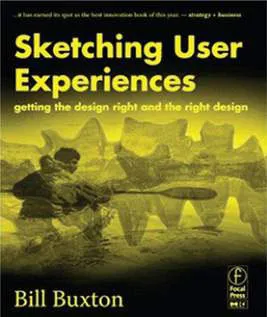![]()
Section 1
Getting into the Mood
![]()
Introduction
Let’s get into the sketching mood. What is a user experience? Why is sketching a good way for you to think about and generate user experiences? Why do so many designers carry a sketchbook, and why should you join them? How can you begin sketching to brainstorm and refine your design ideas?
1.1. Introduction introduces why user experience designers need to consider sketching, and how sketching user experiences differs from normal sketching
1.2. Why Should I Sketch? motivates and describes sketching as a design process, where sketching becomes part of the way you think as a designer
1.3. The Sketchbook details the function of your sketchbook: its uses, best practices, and its properties
1.4. 10 Plus 10: Descending the Design Funnel is an exercise that helps you enter the ‘design funnel’ by sketching out a multitude of ideas
![]()
1.1 Introduction
sketching the user experience
Mission
To give you, the novice to intermediate user experience designer, step-by-step instructions on a variety of sketching techniques.
What This Book is About
Sketching has long been a best practice for designers. Through sketches, designers follow a generative process of developing, honing, and choosing ideas. Designers also use sketches to discuss, exchange and critique ideas with others.
User experience designers are a special breed of designer, for they focus on creating a user experience that unfolds over time. Thus their design sketches need to incorporate the actions, interactions, and changes of this experience across time. In this workbook, we use step-by-step instructions to teach various sketching methods that capture this time element. Collectively, these methods will be your sketching repertoire: a toolkit where you can choose the method most appropriate for expressing your design idea.
Our hope is that you, the user experience designer, will learn these methods with other workmates, which in turn will help you cultivate a culture of experience-based design in your workplace.
Companion Book
You can use this workbook as is. However, you will get even more out of it if you read Bill Buxton’s book: Sketching User Experiences: Getting the Design Right and the Right Design, Morgan Kaufmann (2007). That book is somewhat more theoretical, and will get you thinking about why you should sketch, while this workbook serves as a how-to guide to actual sketching methods.
You don’t have to read Buxton’s book, as we summarize his main points in Chapter 1.2. While we still recommend his book for its deeper background and discussions (and because it is also fun to read!), our summary should get you into the right frame of mind.
Why Sketch?
When you learn and apply these sketching techniques to your daily design practice, the act of sketching will help you:
– think more openly and creatively about your ideas;
– create abundant ideas without worrying about their quality;
– invent and explore concepts by being able to record ideas quickly;
– record ideas that you come across;
– discuss, critique, and share ideas with others;
– choose ideas worth pursuing;
– archive your ideas for later reflection;
– have fun creating while designing.
Doing Rather Than Reading
Reading about a sketching technique is different from actually doing the technique. In this workbook, we choose examples that encourage you to do these sketching techniques as you read about them.
• The examples we use to illustrate the sketch method are deliberately trivial, so that the focus is on the sketching technique rather than on the interface being created.
• The sketched examples are designed to be easy to reproduce.
• The instructions are supported with rich graphical layouts and photographic images to provide visual references and to make the steps more memorable.
• The chosen sketching techniques are inexpensive. The materials and tools required to do a particular technique are commonly available, well documented, and have a reasonably low learning curve.
Audience
You, the Reader
You are likely a person who wants to learn, understand, practice and even teach experience design. This includes all professionals, amateurs, and students with interests in user experience design, interaction design, interface des...


